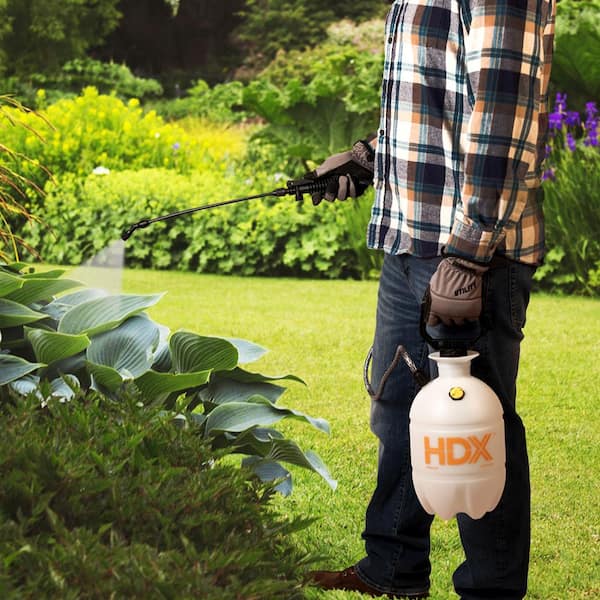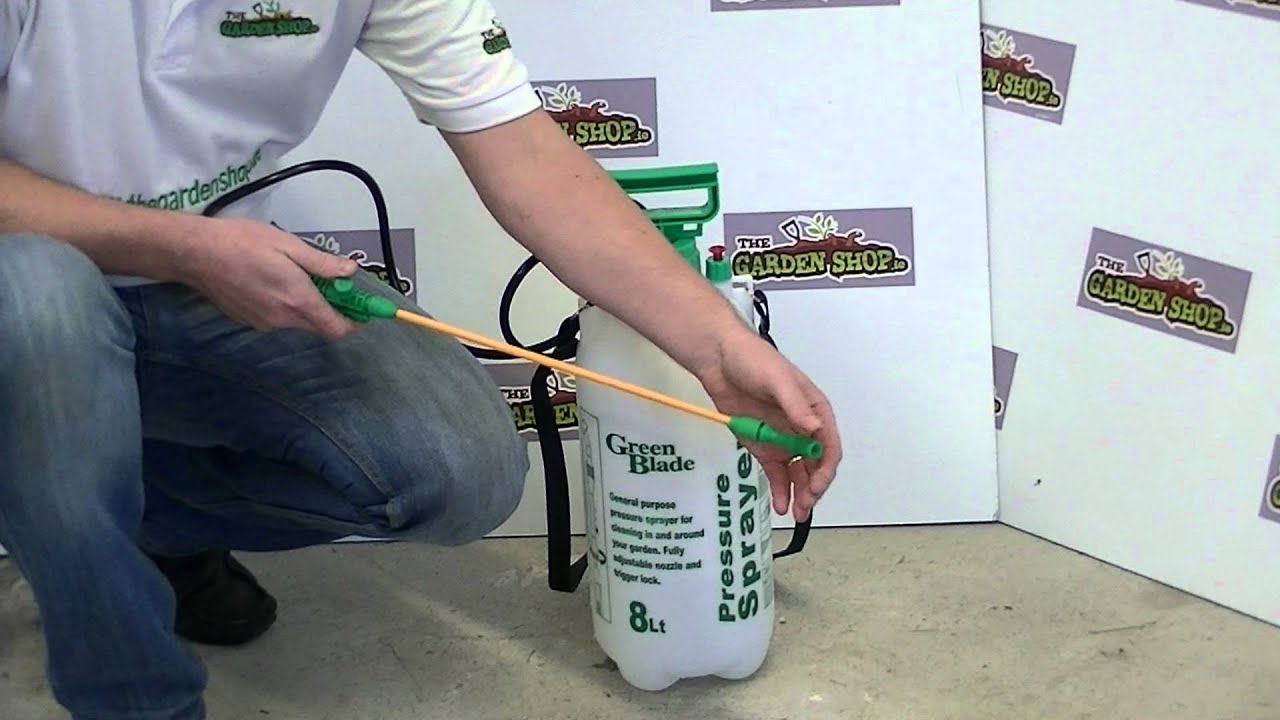To use a sprayer for your garden, fill it with desired liquid, adjust the nozzle, and press the trigger to spray. Using a sprayer for your garden is a convenient way to apply pesticides, herbicides, fertilizers, or water to plants.
Sprayers typically consist of a tank, a pump, a wand with a nozzle, and a trigger. To use the sprayer, first, fill the tank with the liquid or solution you want to apply. Then adjust the nozzle to your desired spray pattern, whether it be a fine mist or a direct flow.
Finally, press and hold the trigger to release the spray, moving the wand back and forth to cover the desired area. Be sure to follow the instructions and safety precautions provided by the manufacturer for the specific sprayer you are using.

Credit: www.homedepot.com
Factors To Consider When Selecting A Sprayer
Factors to consider when selecting a sprayer include the size and layout of your garden. Assess the dimensions of your garden to determine the type and capacity of sprayer needed. Additionally, take into account the types of plants you have and the common pests you encounter.
Certain plants may require specific sprayer features such as adjustable nozzles or different spray patterns. Moreover, consider the type of sprayer that suits your needs, whether it’s a handheld sprayer for smaller areas or a backpack sprayer for larger gardens.
Look for features like a comfortable grip, adjustable straps, and a large tank capacity to make your spraying tasks easier. Finally, consider the durability and maintenance requirements of the sprayer to ensure its longevity. By carefully considering these factors, you can select the right sprayer for your garden needs.
How to Use Sprayer for Garden: Effective Tips
Preparing Your Sprayer For Use
Preparing your sprayer for use involves cleaning and maintenance to ensure proper functionality. Assemble the sprayer carefully. Test it for proper functionality before you start using it. Following these guidelines will help you optimize the use of your garden sprayer.
Best Practices For Using A Sprayer In Your Garden
Using a sprayer in your garden requires following best practices for optimal results. When mixing and diluting chemicals, always follow the manufacturer’s instructions. Adjust the spray patterns and pressure to suit the plants and pests in your garden. Ensuring even coverage is essential for effective pest control.
Target the pests directly and avoid spraying non-target areas. By adhering to these guidelines, you can efficiently use a sprayer in your garden for maximum effectiveness. So, make sure to mix and dilute chemicals correctly, adjust the spray patterns and pressure, and aim for even coverage when targeting pests in your garden.
Safety Measures When Using A Sprayer
Safety should be your top priority when using a sprayer in your garden. Wear protective clothing and equipment, such as gloves and goggles, to safeguard yourself. Properly handle and store the chemicals used in the sprayer to prevent any accidents or contamination.
Consider the environment by using eco-friendly and biodegradable chemicals whenever possible. Remember to follow all manufacturer instructions and guidelines for the sprayer to ensure safe and effective usage. By adhering to these safety measures, you can enjoy a well-maintained garden without compromising your health or the environment.
Troubleshooting Common Sprayer Issues
Troubleshooting common sprayer issues is essential for effective garden care. Clogged nozzles can hinder proper spray distribution. Uneven spray patterns may result from incorrect nozzle adjustment or worn-out parts. Leakage and dripping could be caused by loose fittings or damaged seals.
To resolve these problems, start by cleaning clogged nozzles with a needle or wire. Adjust the nozzle settings to ensure an even spray pattern. Replace any worn-out or damaged parts. Tighten fittings and replace seals if necessary. Regular maintenance and inspection can prevent these issues from occurring.
Keeping your sprayer in good condition will ensure optimal performance in your garden. So, pay attention to these troubleshooting techniques for a successful gardening experience.
Maintenance Tips To Extend The Lifespan Of Your Sprayer
Maintenance tips for extending your sprayer’s lifespan include cleaning after each use, regular inspections and repairs, and proper storage and winterization. Cleaning your sprayer after each use prevents clogging and ensures optimal performance. Regular inspections and repairs help identify and fix any issues before they become major problems.

Proper storage and winterization protect your sprayer from the damaging effects of cold weather. By following these maintenance tips, you can prolong the lifespan of your sprayer, saving you money in the long run. Keep your sprayer in top shape by taking care of it after each use, regularly inspecting and repairing it, and storing it properly.
Alternative Spraying Methods For Specific Garden Needs
Alternative spraying methods for specific garden needs include handheld sprayers for small spaces, backpack sprayers for mobility, and hose-end sprayers for quick applications. Handheld sprayers are ideal for reaching tight corners and delicate plants. Backpack sprayers allow you to move freely around the garden while carrying the sprayer on your back.
Hose-end sprayers are perfect for covering larger areas quickly and efficiently. Each method has its advantages depending on the size and requirements of your garden. Whether you have a small balcony garden or a sprawling backyard, there’s a sprayer that suits your needs.
Experiment with different spraying methods to find the one that works best for you and your plants. Remember to consider factors such as ease of use, portability, and coverage when choosing a sprayer. Take the time to understand the specific needs of your garden and choose the appropriate spraying method to ensure healthy and fruitful plants.
Tips For Cleaning And Storing Your Sprayer
Cleaning and storing your sprayer properly is essential for its longevity and optimal performance. Firstly, flushing out residual chemicals is crucial to prevent clogging and ensure the next use is clean. Remember to disassemble and clean the nozzles thoroughly, removing any debris or buildup.
This will maintain the sprayer’s effectiveness. Finally, store the sprayer in a cool and dry place to prevent damage from extreme temperatures or moisture. Following these tips will help you keep your sprayer in top shape and ready for your garden needs.
Proper maintenance is key to getting the best results from your sprayer and ensuring its longevity. So, make sure to incorporate these steps into your sprayer care routine.
Frequently Asked Questions Of How To Use Sprayer For Garden
How Do You Use A Sprayer For Your Garden?
To use a sprayer for your garden, fill it with the desired liquid, adjust the nozzle for the desired spray pattern, and pump or pressurize the sprayer. Then, simply aim and spray the liquid onto your plants, covering the areas you need to treat or water.
Regular maintenance and cleaning of the sprayer will ensure optimal performance.
What Are The Different Types Of Sprayers For Gardens?
There are various types of sprayers for gardens, including handheld compression sprayers, backpack sprayers, powered sprayers, and hose-end sprayers. Handheld compression sprayers are portable and require manual pumping, while backpack sprayers are worn on the back and provide a larger capacity.
Powered sprayers are battery or gas-powered for easier spraying, and hose-end sprayers attach directly to a garden hose for convenient application.
How Do I Choose The Right Sprayer For My Garden?
When choosing a sprayer for your garden, consider factors such as the size of your garden, the type of plants you have, and the treatments you plan to apply. Handheld sprayers are suitable for small gardens, while backpack or powered sprayers are ideal for larger areas.
Additionally, ensure the sprayer has the necessary features for your needs, such as adjustable nozzle settings or different spray patterns.
Conclusion
Using a sprayer for your garden offers a multitude of benefits. Not only does it save you time and effort compared to traditional watering methods, but it also ensures an even distribution of water and nutrients to your plants. By following the steps mentioned you can maximize the effectiveness of your sprayer and promote healthy plant growth.
Remember to choose the right type of sprayer for your needs, properly mix and apply the desired solutions, and regularly maintain and clean your equipment. Whether you have a small backyard garden or a large vegetable patch, incorporating a sprayer into your gardening routine can greatly enhance your overall success.
So why wait? Take advantage of this versatile tool and watch your garden thrive with lush, vibrant vegetation all year round.

